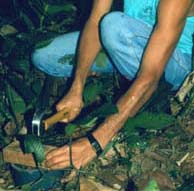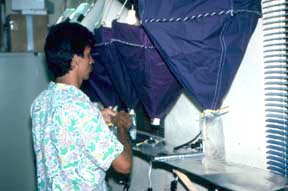 |
|
|
||||
|
|
|
|
|
|
|
|
 |
|
|||||
|
|
|
|
|
|||
|
|
|
|
|
|||
|
|
|
|
||||
|
|
|
|||||
|
|
|
|
||||
 |
 |
|
||||
|
|
|
|||||
|
|
|
|||||
|
|
|
|||||
|
|
|
|||||
 |
|
| Berlese samples |
|
| Canopy Fogging samples | |
| Flight-intercept samples | |
| Blacklight | |
| Malaise samples | |
| Pitfall samples | |
| Salticidae Project | |
|
Berlese Samples A quantitative sampling program was carried out from March 1993 to March 1994. Sixteen areas were selected on a La Selva station map, stratified by soil type (alluvial vs. residual) and forest type (primary vs. secondary). This design yielded four replicates for each soil and forest type combination. Sites were easily accessible from a trail system, but widely dispersed.
Soil/litter cores were taken from 10m distance in a random direction from a central point (the pole of a malaise trap at the same site). The sample was taken by quickly placing a 14.5 cm inside diameter, 10cm deep PVC ring on top of the leaf litter, driving it into the ground, dislodging it, and placing the approximately 1.5 l of soil and litter in a plastic bag. The samples were returned to the laboratory on the same day and placed in Berlese funnels. Because tropical soils are often wet, collapsible cloth funnels were used to avoid the condensation that often occurs on more traditional metal funnels. A breathable synthetic fabric (Ultrex) was used for funnel construction. The sample bed was a 35 x 35cm piece of 6.6mm mesh hardware cloth, overlain with several layers of cheesecloth. The soil sample was broken apart and spread out on the cheesecloth. An incandescent light bulb was placed 15-20cm above the sample bed and the bulb and the sample covered with a pyramidal aluminum-foil shield. Samples were left under a 25 watt bulb for two days, then under a 50 watt bulb for a third day. Arthropods were collected in a Whirlpac bag filled with 75% ethanol suspended from the bottom of the funnel.
Samples were taken at the beginning and middle of each month for 13 months. After three months of sampling, the sampling regime at four distant sites (3 primary forest residual soil, 1 secondary forest residual soil) was altered because it took too long to reach them. To replace the outlying Berlese sample sites, four new sites were established closer to the laboratory (maintaining the same habitat stratification). Berlese sampling commenced at these new sites, twice per month, 10m distant in a random direction from a central point. |



